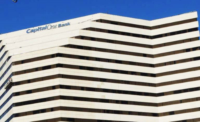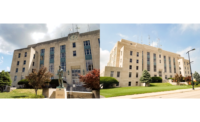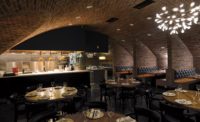Replacing Failing Brick Façade
The inside story to a complete renovation of a Minnesota Hampton Inn outfitted with ReVyvit.

A close up of post renovation exterior with new windows and mix of cladding materials.

Pre renovation.

Post renovation.

Pre renovation close up of failing thin brick.

Exterior renovation showing the installation of Backstop NT liquid applied air and weather barrier.





The Hampton Inn in Maple Grove, Minn., was originally clad with thin brick adhered directly on top of a thin extruded insulation and insufficient weather barrier, all of which were poorly installed according to third party inspectors. As a result, the entire building was leaking and suffering from moisture intrusion.
Needing an attractive weather-tight solution, the owner TPI turned to Dryvit, which employed its ReVyvit by Dryvit renovation solution, to renovate the building exterior completely. The renovation required stripping off the original cladding to the studs, and installing an Outsulation system to create a continuous insulation solution that resulted in a better performing, more attractive building.
A leaking exterior with thin brick actually falling off the wall was more than enough to convince TPI Hospitality, the owner of the Hampton Inn in Maple Grove that their building was in need of a substantial renovation.
“The brand wanted to upgrade the look of the outside of the building,” says Robert Smith, senior vice president of facilities maintenance for TPI. “But one prevailing issue was every year we would have to re-glue several of the bricks back on to the building. Therefore, we knew we had some type of an adhesion issue with the brick. We decided to do a little further inspection and that took us into the structure behind. That is when we saw the moisture damage we were experiencing from the breaks in the fascia.”
The Game Changer
Faced with a dual goal of wanting to enhance the building’s exterior aesthetic and find a solution to the exterior performance issues, TPI and project architect Cities Edge Architects turned to ReVyvit by Dryvit. This new service launched by Dryvit in 2016 simplifies the renovation process by providing building owners and their consultants with one stop access to quality products and installers, third-party inspectors, forensic engineers, energy analysts and financing resources.
Project Team
OWNER: TPI Hospitality, Hampton Inn (flag)
ARCHITECT: Cities Edge Architects
GENERAL CONTRACTOR: Eagle Building Company
APPLICATOR: W.E. Nelson Stucco Company
DRYVIT DISTRIBUTOR: Lutz Company
Among the earliest players Dryvit brought to the team was Jim Geisen, president of W.E. Nelson Stucco Company.
“This project was a kind of unique project as we had a lot of components. We had a complete remediation, meaning a complete teardown, and a complete rebuild with several unique products: stucco, EIFS, stone, Custom Brick and also a complete window removal and replacement. So, it was the complete exterior,” says Geisen.
The Plan of Attack
In this case, the plan of attack called for a complete removal of the exterior cladding down to the original studs, followed by the installation of the Outsulation Plus MD system and multiple Dryvit finishes, including Custom Brick, to give the building a sophisticated look and match the municipality’s preferred brick exterior aesthetic.
“The original thin brick on the exterior had some locations where the system itself just had nothing behind it, that was substantial. The wood had deteriorated from moisture damage and there really wasn’t anything holding the brick up. You could pop some of the bricks out; just grab them and pull them right off with the wall. So it was a pretty bad situation at the time,” says Kevin Hanson, project manager for Cities Edge Architects. “Our challenge was to either go with another thin brick system, which didn’t perform well for us the first time, or put on a full bed masonry veneer, which would be quite expensive. The foundation system wasn’t designed to carry full depth brick; so, there would be some real engineering and expense to do that. Then we found the EIF system, which was going to give us the look of the brick without the added expense and weight of a full brick.”
From the general contractor’s perspective, the ReVyvit solution performed exactly as intended, and immediately solved the performance issues with the exterior cladding.
“After working on this project, I could see how the ReVyvit process made it easier for us to consult with the right experts and then give the building a great new appearance whilst making it weathertight with a lasting solution,” says Lance Nordin, senior superintendent for general contractor Eagle Building Company. “By sealing up the building with Dryvit’s air/weather barrier and then putting on the EIF system with the added insulation on the exterior of the building, I’m not surprised that their energy savings are increasing in a hurry.”
Dryvit Distributor, Tim Lutz, one of the principals at Lutz Company in Brooklyn Park, Minn., said the city of Maple Grove needed some convincing to allow the hotel owners to use Custom Brick instead of the thin brick it was replacing. After working with architects Cities Edge and producing some samples, the city permitted the renovation to go forward. Everyone has been happy with the result.
“When you drive by it, even close up, you would think that it’s clay brick and driving by it on the freeway—I drive by it quite often and it looks fabulous. I mean, the detail and the cornices that are way up on the top look good. They really did a great job,” says Lutz.
In addition to the major facelift and aesthetic improvement, the renovated building has been performing significantly better from an energy efficiency point of view. In fact, the owners immediately began to see a lowering of their energy costs after renovating with ReVyvit.
“I’d like to stress how much more seal tight everything is. It’s tight, it’s clean, it looks fresh and new, and now we’ve even been through winter. We don’t have windows that have condensation on them; none of that anymore,” says Mark Maves, general manager of the property. “I think that during the year we’ve had this product on our building, we’ve probably reduced our energy costs by 25 to 30 percent; and that makes me very happy.”
Nordin was particularly impressed with the Dryvit Backstop NT liquid applied air and weather barrier that was specified instead of the more traditional sheet paper weather barrier.
“What we’re accustomed to is installing sheet wrap around the building to where you’re just putting up paper around the building. With this particular application, you’re putting on a liquid membrane, so you’re actually sealing it directly to the exterior sheathing, which is a huge bonus. You can see it sealed up with no seams. That’s one of the major advantages right there,” Nordin adds.
“Just the way all the components came together, the natural stone, the EIFS with the Custom Brick, along with the decorative rebuilt cornices up on top – the building is just beautiful. It is a show piece,” says Jim Geisen.
Looking for a reprint of this article?
From high-res PDFs to custom plaques, order your copy today!












